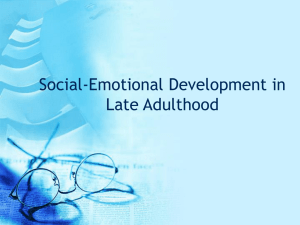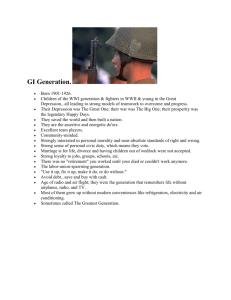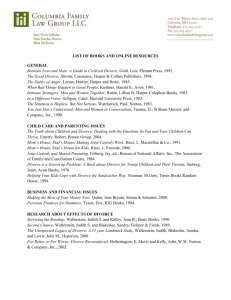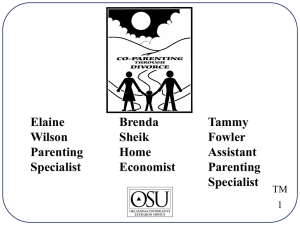The Effects of Divorce on Adolescents
advertisement
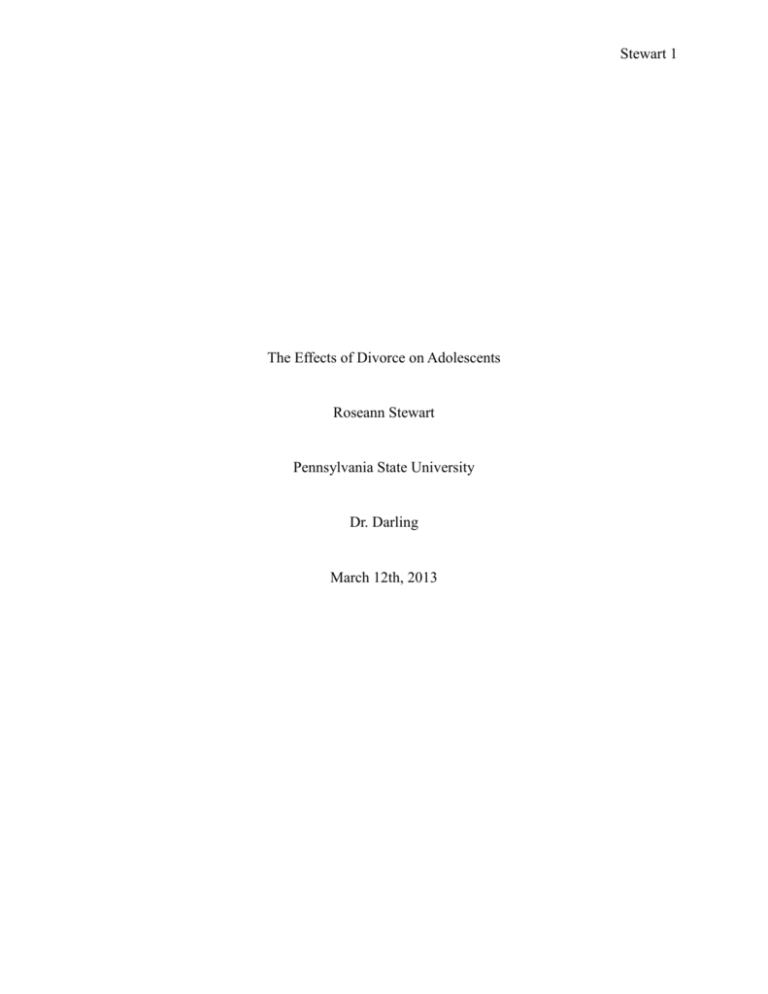
Stewart 1 The Effects of Divorce on Adolescents Roseann Stewart Pennsylvania State University Dr. Darling March 12th, 2013 Stewart 2 ABSTRACT There are some negative assosociation between divorce and adolescent well being. Stewart 3 There has been ample research into children's adjust after their parents have divorced each other. Many researchers found there to be negative effects of divorce and how the child or adolescent reacts to the divorce varies. Researchers have also found that many factors such as time after the divorce, age when the divorce occurred, and gender contribute to how the adolescent react to the sudden change in lifestyle (Lansford, 2009). Children and adolescents of divorced parents are at a higher risk of low academic performance in school, internalizing their feelings or externalizing emotions and poor social skills (Lansford, 2009). The purpose of this paper is to review literature to discover any negative associations that divorce may have on adolescents. ECONOMIC HARDSHIPS After a split from their significant other, the newly divorce parents face financial hardship in supporting their children. The money becomes limited and stretched thin so the adolescents may not be able to get everything they need when they need it due access to only one income. The stress of the lack of finances puts negative pressure on the parents to provide with what little they have unintentionally influences the adolescent into depression. Adolescents of divorced parents are at higher risk of developing depression than adolescents in a two-parent home (Aseltine, 1996). Many parents as a result of divorce have lower incomes that put them and their children into poverty levels. The families often have to move to a lace that accommodates their new Stewart 4 living situations. The children then display emotional and behavioral problems while trying to cope with their new life. Meanwhile children that come from intact families show lower signs of having any behavioral or emotional problems as children of divorced parents (Lansford, 2009). EXTERNALIZING BEHAVIORS Delinquency According to Burt, Barnes, McGue and Iacono (2008), adolescent delinquency is not linked by a common gene. These researchers set up a study to support the idea of a common gene for adolescent delinquency post divorce among birth or adopted siblings. The participants were drawn from a population-based study of birth and adopted siblings. The participants and parents were assessed with self-reports, adolescents used a test from the DSM-IV while parents used a reliable questionnaire about their marriage. The study found as stated above that a common gene is not responsible for adolescent delinquency but how the adolescent experienced the divorce itself that led into the delinquency. Some evidence does show that adolescent delinquency may be a predated problem to divorce. Although the study did find a positive association between adolescent delinquency and divorce, the associatio,n at one percent, was very small (Burt, Barnes, McGue and Iacono, 2008). Aggression Hamana and Ronen-Shenhav (2012) found that adolescents of parents who divorced selfreported to having additional feelings of aggression than their peers in intact two parent families. Stewart 5 This finding is supported with research done by other researchers on this subject matter of behavioral issues within adolescents of divorced parents. GENDER DIFFERENCES If parents divorced during the adolescent years then boys were more likely to externalize their behavior than girls up to a year after the divorce. After the year, the boys externalizing behaviors would drop down significantly (Lansford, 2009). Girls are less likely to have thoughts of hostility and act out physically than boys after a divorce, which for boys is viewed as socially acceptable. (Hamana and Ronen-Shenhav, 2012). According to Silverberg Koerner, Wallace, Jacobs Lehman, Lee, & Escalante (2004), divorced mothers are more likely to speak about sensitive topic or be more sensitive to their daughters rather than their sons, this occurring within two years after the divorce is finalized. This suggests that mother-daughter relationships are more intimate and more open than those of mother-son relationships. Female adolescents are more sensitive and need a caring person to guide them as they form their personalities into a more sensitive one. Silverberg Koerner, Wallace, Jacobs Lehman, Lee, & Escalante (2004) also found that daughters were more in favor of getting more attention from parents and emotional support than the sons. When compared to intact two parent families, the daughters of divorced parents showed higher risk of becoming depressed or showing depression symptoms. Stewart 6 Contrary to Silverberg Koerner, Wallace, Jacobs Lehman, Lee, & Escalante (2004), Risch, Jodl, and Eccles (2004), conducted a longitudinal study on the father-adolescent relationship after a divorce. Some statistically significant findings were adolescent sons that were close to their fathers prior to divorce continued that same closeness through adulthood and felt as though they would not get divorced in their lifetime. The father-son attachment allowed more positivity about the divorce. As for the daughters in this study, the father-daughter relationship did not interfere with the daughter's perception on marriage or the divorce. LIMITATIONS Many of the studies conducted were after the parents have divorced and the children appeared to be suffering in various ways. The main limitation to the studies were that there was not a baseline to how the children's or adolescents' behaviors were prior to the divorce leading researchers to presume some of the problems such as externalizing and internalizing behaviors may have been present before. Most of the studies run into problems such as timing of effects after a divorce. The amount of time the parents have been divorced is significant in determining how a child may be impacted to the situations (Lansford, 2008; Silverberg Koerner, Wallace, Jacobs Lehman, Lee, & Escalante, 2004). This gives way to more longitudinal studies to be conducted to give a better look into divorced families over the years. Stewart 7 The sampling size on some of the study should be larger so that the research can be used to generalize the population of divorced families and intact two parent families also. The researchers must take into account that in order to generalize the sample must be spread out over the nation instead of in region to capture an accurate representation of the population. The race of the majority of the families that were studied was white families. Although the majority of the United States is white, researchers should find a way to sample more minorities so the human services field may have an understanding to how different culture deal with divorce and the effects that it may have on the children and adolescents as well as the parents. CONCLUSION Divorce is a process that not only affects the parents but affects their children greatly. Divorce can leave the children feeling alone or feel that they have to choose the side of one parent or the other. The economic hardships of tearing the household in half with only one income to live of off can be stressful to the parent and cause depression amongst adolescents. Other negative effects of divorce are externalizing behaviors such as delinquency and aggression in the adolescent. Adolescent delinquency did show to have a positive association with divorce but it was not large enough to make generalizations off of. The other negative effect, aggression, also proved to have a positive association to divorce when compared to intact two parent families. These findings could not be used for generalization because it was not representative of the population. Stewart 8 Some research found gender differences among their sample. It was found that males are more likely to externalize behaviors and females were more likely to internalize their behaviors as a result of a parental divorce. While females could seek guidance and support from their mothers, who seemed to show more sensitivity towards their daughters, the sons did not have evidence of having that same treatment. When it came to the father-son relationship attachment, adolescent sons learned more from their fathers about how to maintain intimate relationships that last long.



